#Hugues de Payens
Photo

Hugues de Payens, premier grand-maître de l'ordre du Temple by Henri Lehmann
The Michael Impulse of the Knights Templar
Reflecting at length on Baldwin IIs request, Bernard realized that the spiritual model of the knights of the Temple was not in contradiction to his convictions. Indeed, it offered knights a way to escape the violence and perdition of secular life because it bound them to take up arms only for the defense of a just cause, thus helping shape the life and thought of the social elite to become more Christian. This was the same goal toward which reformed monasticism had been actively working for two centuries.
The key lay in the penitential intentions of the knights of the Temple and in the purely defensive aims that charac- terized the early days of Hugh de Payens’s brotherhood. Those who became Templars wished to atone for their sins by risking their lives to defend the Holy Land. It was a lifelong crusade, and if they died, their souls would be those of men who fell in service to the church and the faith. Killing Saracens meant murdering murderers, eliminating those who had made themselves the instruments of evil: this was not homicide but malicide, the killing of evil. As Saint Michael the Archangel, leader of the celestial forces against the powers of darkness, defeats the devil in the great battle of the last day, so does the Templar knight serve the faith by defeating its enemies. And isn’t the Virgin Mary herself, to whom Bernard was devoted, the one who crushes under her foot the head of the serpent, the incarnation of evil?
The ethic of war would lend itself to an honorable cause, but the order would not survive if it lost sight of its original values of penitence and spiritual poverty. The innate arrogance of knighthood would need to be tempered by the inflexible practice of personal humility, so the spirit of service would always come before material objectives and the cause would always come before the individual. The Temple would require the most severe discipline, harsh enough to crush the pride and desire for self-aggrandizement characteristic of the military aristocracy. If knights wished to be Templars, they would have to subject themselves to a regime of absolute obedience, renouncing their free will to submit themselves completely to the will of their superiors.
—Barbara Frale, The Templars: the Secret History Revealed
14 notes
·
View notes
Text
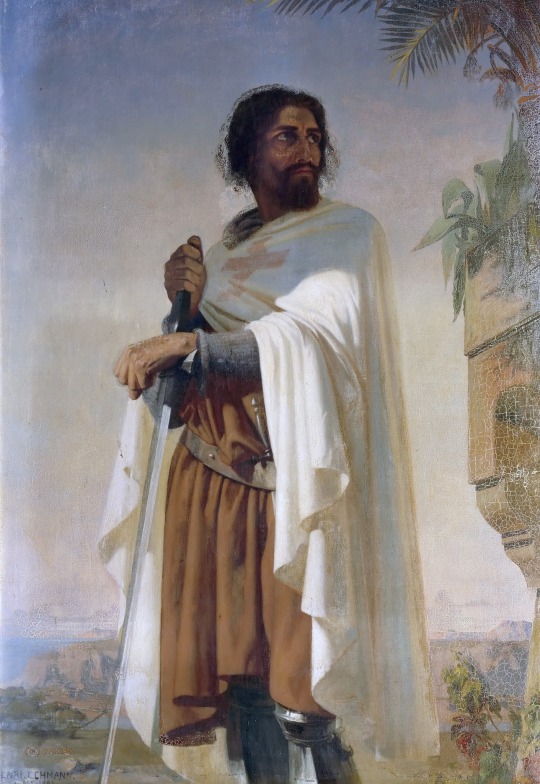
Hugues de Payens, premier grand-maître de l'ordre du Temple
by Henri Lehmann
Hugues de Payens, 1st Grand Master of the Knights Templar
#hugues de payen#art#henri lehmann#founder#grand master#grand maître#knights templar#knights templars#templars#templar#history#medieval#knight#knights#crusader#crusaders#crusades#europe#european#middle ages#christianity#christian#france#château de versailles#palace of versailles#versailles
166 notes
·
View notes
Text
Podcast: The Final Deadly Days of the Knights Templar
Podcast: The Final Deadly Days of the Knights Templar
For almost 200 years, the famous Knights Templar had considerable power, wealth, and influence across Europe and the Mediterranean. But it all came to an abrupt and bloody end in 1314. The Knights were originally founded as a Christian, monastic-military order, devoted to protecting pilgrims traveling to and from the Holy Land following the First Crusade. If a “monastic-military” order sounds a…

View On WordPress
#Crusades#Grandmaster#Holy Land#Hugues de Payen#Jacques de Molay#knights templar#Middle Ages#secret society
0 notes
Text
Alter Ego of Truth and Lies: Hugues de Payens (Full Profile)
*Note that all information in this profile is subject to change at any time.
Class: Alter Ego
True Name: Hugues de Payens
Nickname: Alter Ego, Alter Ego of Truth and Lies, AERT, Hugues de Payens Prototype, Hughes de Payens, Grandmaster Hugues, The First Templar, The Most Righteous of Templars, “Big Sister/Brother,” “Mistaken Fool,” Hugues de Payns, Hugo de Paganis, Hues de Paiens delez Troies("Hugh of Payens near Troyes"), Ugo de' Pagani, Master of the Knights of the Temple
Characteristics
Species: Servant, Human
Gender: Male, Nonbinary, Female
Height: 1.72 Meters
Weight: 90kg with Armor
70kg without Armor
Blood Type: Unknown
Place of Origin: Payens, France
Birthday: 1070
Age: Unknown
Personal Information
Addresses self as: Watashi(わたし), Jibun(じぶん)
Likes: Truth, God, honesty, Knights Templar, the countryside, rustic villages, Saint Mary(the mother of Christ)
Dislikes: Lies, demons, dishonesty, rumors, hearsay, heresy, Knights Templar, secrets, undead
Talents: accounting, managing money and finances, rallying people to a cause
Natural Enemy: Hassan-i-Sabbah, Salah al-Din Yusuf ibn Ayyubn, Knights Hospitaller, and the Teutonic Knights
Image Color: Blood Red, White and Silver
Affiliations:
Knights Templar
Family Members
Thibaud(Son)
Many possible descendants
Servant Stats
Type: Heroic Spirit
Source: Legends of the Knights Templars, Historical fact, Rumors about the Knights Templars
Region: Payens, France
Alignment: Lawful Good
Hidden Attribute: Man
Armaments: Sword, mace, and shield
Known Summoning Catalysts: a sword once used by Hugues de Payens, a mace once used by Hugues de Payens, a coin from some of the money that Hugues de Payens managed, a piece of Hugues de Payen’s shield, and a fragment of Temple Midlothian.
Qualified Servant Classes
Within the prime Fate timelines AERT is an entity that split off from the original/true Hugues de Payens(Shielder Hugues de Payens Profile). They are born from a mixture of both truth and some of the rumors surrounding the Knights Templar during/after Jacques de Molay and the Templars he led were accused of and charged with practicing witchcraft and heresy. So great were these rumors that they spread like wildfire and came to affect not only Jacques de Molay but the very image of the Templars themselves. Some of these rumors are what led to the birth of this Hugues. Due to the fact that they are split off from the actual Hugues de Payens they are eligible for all the classes she is eligible for and some extra ones due to their altered mental state and some of the skills they have gained from myths and rumors. Interestingly, within the prototype timelines, this Alter Ego Hugues is the default/real one and is thus not eligible for the Alter Ego class in said timelines.
Alter Ego
This class is a natural fit for a being born from rumors that split off from the original Hugues de Payens. Their existence is a delicate one as they are constantly being pulled mentally in two separate directions. First, there is the side of Hugues and the Templars that was seen as noble, and heroic. Alongside that, there were even some myths that saw Hugues and their knights as holy or on the search for holy objects and relics. Some even believe that they found some of these objects. On the other hand, you have the corruption created by those who saw the very Templars and their entire order as corrupt and rotten with heresy and witchcraft. AERT is constantly being pulled towards either side. While they try to uphold and perform the values of their holy order the whispers of countless rumors and accusations constantly try to pull them towards being part of the corrupt order everyone “knows” they are. As if countless people want their suspicions and lies confirmed to be true. This has caused AERT to become more paranoid and to go even further to prove their devotion to God and his faith.
Saber
Many crusaders were well known for their zeal for God as well as the bravery and violence they would display in his name. As a Saber, this part is emphasized and Hugues is noticeably more aggressive and offensive in their close combat fighting style. This is reflected in how Hugues has the Valor skill in this form. This form of Hugues is affected by the more exaggerated and fantastical tales of the Templars than the Saber form of the other Shielder Hugues. In this form, AERT is also unaffected by the rumors that burden the Knights Templar. They also have a Noble Phantasm based on the flag of the Templars. There was a rule that stated no warriors of the Templars should ever surrender unless the Templar flag had fallen, and even then they were to try to regroup with another one of the Christian orders first, such as the Hospitallers. It was only after all the flags had fallen that they were allowed to leave the battlefield. As a Noble Phantasm, this flag makes Hugues and any Knights Templar within its range unable to die until the flag is either destroyed or falls, or until Hugues runs out of mana.
Rider
The crusades were massive war campaigns in the name of God and the holy land. This fact is epitomized when Hugues is summoned in this form. They specialize less in one on one combat and more on directing and summoning large armies.
Berserker
It is well known that the crusades were quite violent. Despite how many crusaders felt like they were fighting for a holy cause, it is unsurprising that during battle many of them would have been overtaken by anger or embraced rage. With some believing their anger to be the wrath of God or striving to be the embodiment of God's wrath on the battlefield. In this form Hugues has access to a version of the Noble Phantasm Deus Vult: The Rallying Dream of the Crusaders. But it acts slightly differently, as the Noble Phantasm will not end until all of their opponents have been killed and/or defeated or Hugues and their army dies.
Shielder
This Hugues’ shielder form is somewhat different from the female one. In this form AERT specializes in defensive formations meant to protect the holy land and its faithful pilgrims. Due to this AERT takes the form of a noble protector with abilities that allow them to protect holy sites, saints and people of the same faith. However, these same abilities damage and bring drawbacks upon those of different religions, demonic entities, or those who wield black/demonic magic.
Foreigner
In this form Hugues has succumbed to the corruption of rumors and has taken on a heretical form based on the lies told about the Knights Templar. Hugues has had their form twisted by this on top of becoming possessed by an outer god. In this form they wield powerful black magic and demonic magic. It is possible that Jacques de Molay(Foreigner) has something to do with this form’s existence. Meaning that there is a chance this form can only be summoned under specific circumstances or when Foreigner Jacques is present.
Ruler
In this form Hugues’ side that follows the way of god has won out, standing above all the rumors spread about their order. The legends of the Templar finding holy artifacts has also further amplified this form’s resistance to the corruption of rumors. They are saint-like and have no wish for the grail themselves(qualifying them for this class), only wishing to observe and protect the grail and fight in the name of God.
Avenger
In this form Hugues has succumbed to the corruption of rumors and has taken on a heretical form based on the lies told about the Knights Templar. Unlike their Foreigner form, however, they are not possessed by any outer god. So they seek vengeance on all those who falsely accused and besmirched the good name of the order of the Templars through any means necessary.
Other Versions- Shielder Hugues de Payens(Shielder Hugues de Payens Profile)
Parameters
Strength: A
Endurance: B+
Agility: D
Mana: B
Luck: C+-
NP: A+
Hugues’ luck stat is odd since it has both a + and a -. What this means is that AERT’s luck is unstable and has a chance of jumping up to an effectiveness greater than that of B rank or dropping in effectiveness to a point where it is less effective than a luck stat of D. They also appear to be slower than that of the real Hugues. Their Endurance has also slightly dropped due to not being in a more defensive shielder form.
Class Skills
Magic Resistance: B++
At B rank, it is a skill that cancels spells with a chant below three verses. Even if targeted by greater magecraft and Greater Rituals, it is difficult for the user to be affected.
In the case of AERT the skill increases in effectiveness when resisting holy and/or demonic magic and magecraft.
Riding: C
At C rank, it is a skill that allows one to flawlessly manage beasts and vehicles if they have received the proper training and adjustments. Most vehicles and animals can be handled with above average skill. However, the user cannot ride the likes of Phantasmal Species such as Monstrous Beasts.
In life Hugues could ride horses quite well which has translated to having this skill.
Madness Enhancement: E-
At E rank the user does not receive the benefits of Mad Enhancement nor do they lose any of their reasoning abilities, and overall they just become a little rougher.
This would be a much higher rank if AERT was summoned as a Berserker. At this rank it does also make Hugues slightly more focused on proving faith through combat and numbs their ability to feel pain to a degree.
Personal Skills
Defense of the Faithful: C
A skill that acts as a variation of the Self-Field Defense Class Skill of the Shielder Class. Like Self-Field Defense, it protects allies and allied territory, with the skill’s range increasing the higher the rank, but unlike Self-Field Defense it only works on those who the owner deems to be faithful or shares the same religious beliefs as them.
Given that Hugues de Payens was the first Grandmaster, their desire to protect their Order´s true purpose and those who devote their life for said Order manifested as a Defensive Barrier made to protect soldiers and pilgrims alike who are faithful and wish to journey to the Holy Land.
Charisma of the First Grandmaster: B+
A skill born out of the fact that Hugues de Payens was the first Grandmaster of the Templar Order, not only were they Cofounder of the Order alongside their friend Bernard of Clairvaux, but they were considered the most capable person of leading it, being capable of proving their prowess both as a spiritual and military Leader during the 20 years they served as the Order´s Leader. They are capable of inspiring almost anyone who has joined their order to follow them. It appears that in the case of AERT the skill’s effectiveness has dropped one rank. This is due to the influence of rumors making people less trusting of the Knights Templar order in general.
Vow to Renounce Temptation: C+-
A Skill born out the vow Hugues and the other original Templars took once the Order was first created, it's a decree that states that they will renounce the world and all of its temptation, material wealth, etc. in order to attain purity in the name of God, it's a skill that shows their devotion for their cause as a Templar, being ready to renounce anything in the name of the Lord almighty. For AERT it has been lowered a rank due to their Innocent Monster skill. Making it less effective as well as less stable and more prone to fluctuations in its effectiveness.
Latin Rule: A++
A special Skill that in truth is one of the Noble Phantasms Hugues de Payens has in possession, it's described as a code of honor that all Templars had to uphold which was written by both Bernard de Clairvaux and Hugues de Payens. It describes how the Knights should behave at all times both in and out of battle, stipulating the needed punishments to be taken if it wasn't fulfilled. Innocent Monster has caused this skill to drop one tank.
Golden Rule: C
A Skill that refers to the measurement of one's fortune to acquire wealth. With this skill money will seem to find its way towards a servant.
The Templars are notable for being prominent in the field of finance and Hugues helped establish the order as a financial institution. Like their institute, Hughes is proficient at handling money which has manifested as this skill. While this skill does not guarantee they will be rich it does prevent them from accidentally becoming broke or falling into debt.
Innocent Monster: C+-
An attribute possessed by Servants whose true history and existence have been distorted by the monstrous reputations and gossips they accrued across the course of their life and thereafter, without concern for the actual person's will or appearance. As a consequence, the Servant's abilities and appearance have been rendered to conform to the specifications of their legend. Incidentally, this Personal Skill cannot be removed. Hugues is constantly fighting off the mental effects of this skill with faith so it often drops in effectiveness. This skill has a chance of rising in potency if AERT is hit with a demonic or black magic attack and will decrease in potency if hit with a holy or divine attack.
This skill can potentially affect many of the Servants in the Knights Templar due to the rumors of heresy, demonic magic, and black magic surrounding Jacques de Molay and the Templars. Hugues considers it their burden and believes that it will be dispelled once they dispel all the rumors and lies told of their order. To them it is a reminder of the shortcomings of the order and proof that either their faith wasn’t strong enough or that they didn’t perform God's will enough. It appears that the effectiveness of this skill is also tied to Hugues’ master. If said master is one of faith or believes Hugues to be one then the skill is less effective. But if they practice heretical teachings or believe the rumors about the Templars then the effectiveness of the skill will be raised.
Noble Phantasms
Liber de Laude: Praise to the Righteous Templar- Rank A(Anti-Unit (Self)), Maximum Number of targets 1~20,000
Liber de Laude, also known Liber ad milites templi de laude novae militiae which roughly translates to “Book to the Knights of the Temple, in praise of the new knighthood” is a book attested to Hugues de Payens, written by Saint Bernard of Clairvaux which served to boost the morale of all of the Templar Knights due to its tone and timing. The book was something Hugues de Payens desired to write in order to maintain the hope, faith, and morale of their Templars, but due to unknown circumstances was unable to write it themselves, thus they asked for help from their friend Bernand to write it for them, even going as far as to have asked him 3 times to write such texts for their knights. Bernard mentions in the text that it was all the idea of Hugues themself, as the text both talked about how much knighthood had fallen since the Age of Knights and how the Templars, unlike other contemporary knights, remained just and righteous, with them being the last defenders of the God almighty´s teachings, equating their crusade as a righteous journey that they must go through to achieve salvation. Despite the worries the Templars of said time had on whether their cause remained just or not, Hugues and Bernand ensured to write something to keep their morale up in order to reach their ideal of salvation.
This Noble Phantasm works by essentially rallying up the forces under Hugues’ command, essentially boosting their morale to continue fighting no matter how dire or difficult the situation may be, convincing them that their fight is a righteous one worth fighting for. Once the Noble Phantasm is activated, it would be as if Hugues read the actual book in its entirety, pointing at the flaws their current enemies possess while highlighting and glorifying all the virtues their allies possess in order to boost them for battle, giving them the belief needed to surpass any enemy as they continue their righteous crusade. Liber de Laude is capable of boosting thousands of Allies at a time, being capable of letting them face enemies that are stronger than them, and even in theory being able to make simple soldiers into fighters strong enough to contend with E Rank Servants, showing the great power and motivation the text truly possesses. But it's far from an all powerful boost as despite being capable of giving a great boost to its allies, they need to truly believe that they are capable of that for the effects of Liber de Laude to take effect, meaning that an ally with great enough Mental Pollution or an enemy with great Resistance to Mental Attacks may not be affected as easily, and also… Just like their Order, it's not a permanent boost and eventually it will fade away.
“Knights are impure savages, driven only by lust and greed
Their path of Knighthood has been tainted, lost by the Evil of Men
But thy path is still Bright oh Brethren in arms, your righteousness can still be shown
Your fearless sacrifice in the name of the Lord won't be in vain, your Holy belief shall carry you onward. So raise up your arms for Battle! Dictate your wish to fight for what is right! Fight for proof of what you truly are! FACE ALL WHO TAINT YOUR HOLY CRUSADE, REACH UNTO THE GATES OF HEAVEN! LIBER DE LAUDE!”
“HEAR THY VOICE FELLOW TEMPLARS AND PREPARE FOR BATTLE!
IT'S TIME FOR YOU TO PROVE YOUR WORTH AS A KNIGHT!
SHOW YOUR RIGHTEOUSNESS AGAINST THOSE WHO TAINT KNIGHTHOOD!
KEEP YOUR HEAD UPTIGHT AS YOUR CHARGE TOWARDS THE GATES OF HEAVEN
YOU ARE THE GUARDIANS OF THE LORD'S TEACHINGS, FIGHT TO PROVE OUR CAUSE!
LIBER DE LAUDE!”
“BURN ALL THOSE WHO DARE CALL US HERETIC!!! LET THEM HEAR OUT TENETS OF FAITH AND KNIGHTHOOD!!! LIBER DE LAUDE!!!”
Deus Vult: The Rallying Dream of the Crusaders- Rank A+(Anti-Army), Maximum Number of targets 1~1,000
This is the legendary chant used to signify the beginning of the crusade, once chanted by Pope Urban in order to trick those poor souls that would die for his ambitions now became a chant of honor and unity between all knights that made up the Templar, a single phrase “God
wills it” which became a symbol for this Holy Crusade… It’s the chant that
united so many people under one single goal. The Holy Crusades weren’t a single event that happened just once, it was a massive moment in Christian history as it saw the rise of various warriors of faith who gave their life to reclaim the Holy Land of Jerusalem as that was the promised land told by the Lord, in fact it wasn’t merely a single Crusade but various which were fought across years by different religious leaders with different amounts of success, an event that shook the Christian world by its sheer magnitude.
All of those who have led a crusade have access to this Noble Phantasm in one form or another. Despite theoretically having the same potential under all of its users, its effectiveness varies depending on how beloved they were as leaders or what crusade they led. So in truth, no two crusader kings would have the same usage of this Noble Phantasm.
Despite not being the leader of any particular crusade, Hugues de Payens is capable of calling forth for the aid of any Templar known throughout history, being able to summon any and all Templars known throughout history to aid them in battle… Summoning any future grandmaster of their order and every nameless soul who truly believed in the ideal that the Templars upheld… and in theory… they could even summon their old friend Bernard through this Noble Phantasm.
Once activated, Hugues will be able to manifest the world where their crusade took place, being able to summon all the different crusaders that fought at her side as Phantoms of humans who lost their name in history, while they lack any sort of skill and class the sheer
numbers that they possess makes them capable of overwhelming even the strongest of servants for a limited amount of time.
Of course, the crusaders summoned are just as strong as humans, so they aren’t hard to get rid of, but their conviction makes them continue fighting even at the brink of death, in some special cases it’s possible for a few to manifest as actual historical figures that have fought in the crusades, but they lack access to their skills and Noble Phantasms. But as expected, such a Noble Phantasm requires a great amount of mana to be used, and in most cases can only be used once per battle before Hugues is forced to squeeze their master out of all the magical energy they possess… Also, this Noble Phantasm, while strong against individual servants, is far from perfect as techniques which have massive areas of destruction, such as many anti-fortress and some anti-army Noble Phantasms, would be capable of wiping out the entire Crusade in mere seconds.
AERT’s version of this Noble Phantasm varies slightly from that of the actual Hugues as they are capable of summoning even fictional Templars as long as enough people believed them to have existed at some point. Furthermore, it gains an increase in effectiveness when it is used to attack someone/something with demonic magic/objects and those wielding holy objects. While the crusade stomps out anything it sees as heretical it is also enhanced by the legends of the Templars searching for and obtaining holy artifacts. If the Noble Phantasm is targeting someone with a demonic object the onslaught of the army will refuse to stop until every soldier has died or the demonic object has been destroyed. If Deus Vult is used to kill someone with a holy object or relic the Noble Phantasm will basically “steal” it. Allowing Hugues to use it as a Noble Phantasm of their own. If this holy object happens to be the Noble Phantasm of another servant it will transfer to AERT with no degradation in rank, effectiveness, or quality.
“IT'S TIME FOR YOU TO RAISE UP YOUR ARMS ONCE MORE!
WE FIGHT FOR GOD'S GLORY, WE FIGHT FOR SALVATION AND THE LIGHT OF TOMORROW! WE SHALL GRACE THE HEAVEN AND REACH OUR RIGHTEOUS PLACE
FOR THE GLORY OF GOD, TO HONOR KING SOLOMON, HEAR THY CALL OH HOLY TEMPLARS DEUS VULT!”
“Our crusade JUST, our faith PURE, or wrath HOLY. Now show all those non-believers just what I am referring to! DEUS VULT!!!”
“IF GOD WILLS IT THEN WHO AM I TO DENY IT!? DEUS VULT!!!”
“This will be a crusade to cleanse the land… DEUS VULT!!!”
Ignea Veritas et Fides: Burn Away the Heretic, the Liar, and the Non-Believer- Rank C(Anti-Unit), Maximum Number of targets 1~10
A manifestation of the more fanatical side of the crusades and the Templars to punish the non-believers and the heretics,
It takes the form of a cleansing flame that coats anything Hugues is holding that they recognize as a weapon. These flames will burn all those who do not believe in the Christian faith or those who practice heretical teachings, such as witchcraft or demonic magic. It is harmless to the likes of true saints or the faithful though. If the fire burns someone who is not on the level of a servant they will be burnt to ash in mere moments. Entities such as servants who are burnt by the flame will feel it and continue to do so until they become a believer of the Christian faith and renounce their heretical ways or until Hugues dies. This also applies to non-servants if they manage to survive through some outside aid or miracle.
This Noble Phantasm also works the same way against existences that are considered “unholy” such as zombies, vampires, and Dead Apostles.
Unfortunately, the partially corrupted state Hugues de Payens takes in their Alter Ego form means that they feel a burning sensation in the parts of their body that have been too corrupted as long as they are using this Noble Phantasm. AERT sees this pain as a test of faith though.
The Noble Phantasm also burns those who are actively lying. This also means Hugues themselves cannot tell a lie while using this ability lest they burst into flames. This Noble Phantasm burns a hotter blue if used within a church or anywhere sufficiently holy.
“As God wills, I will make sure you burn for your deeds! IGNEA VERITA ET FIDES!!!”
“Sinners like you must be punished. IGNEA VERITA ET FIDES!!!”
Secans Mendacium: The Blade of Burning Falsehood- Rank B-(Anti-Unit), Maximum Number of targets 1~10
All the rumors and assumptions people had towards the Knights Templar have coalesced into the physical form of a large strange living cursed sword composed of Phantoms, Wraiths, and rumors. Whenever Hugues wields this sword their Innocent Monster increases by one rank and their Vow to Renounce Temptation decreases by one rank. When used it also pushes them closer to a Templar that all the rumors and lies said the order was. The sword also seems to physically corrupt Hugues every time they unleash its True Name.
The sword constantly whispers to Hugues, beckoning them to worship demons and unleash its True Name. The sword also whispers to those near Hugues and attempts to corrupt those that touch it. So Hugues must remain vigilant and faithful. When the true name is unleashed the sword is bathed in a demonic hellflame that whispers lies and rumors as it burns. This flame is then unleashed in the form of a fiery slash at its target. Those who are hit by the flame will be inflicted with visions and whispers of all those who hate them and all the negative things that the world believes about them. If a servant doesn’t have a strong enough protection to mental attacks they can end up turning into an alter form of themselves if they fail a luck check.
Every time Hugues unleashes this sword’s true name the grip of rumors upon their form becomes stronger and stronger. If AERT uses this Noble Phantasm’s true name more than 6 times then they will be transformed into an alter and lose the “grace of god.” Becoming the heretical knight of witchcraft and demonic magics that many believed the Templars were.
Hugues’ left arm appears to be physically corrupted and weirdly thin and purple. When Hugues wields their Secans Mendacium Noble Phantasm that arm becomes unnaturally muscular. The corruption can be seen trying to spread throughout their body in a vein or root-like fashion. It appears to grow in strength and size whenever Hugues uses Secans Mendacium.
“Please God, have mercy on my soul. SECANS MENDACIUM!!!”
“I am sorry God. I can only ask for your forgiveness. SECANS MENDACIUM!!!”
“If that is what you think the Templars are then FINE. SO BE IT!!! SECANS MENDACIUM!!!”
“I’m sorry my lord God, but I need to win this fight. SECANS MENDACIUM!!!”
Miscellaneous Skills, Abilities, and Equipment
They are trained in the ways of the Church and are extremely proficient with using things like black keys and scriptures in combat. This gives them an edge when fighting the undead and/or unholy as well as other spirits.
They wield a sword that is smaller than their Noble Phantasm. They often use this as their main weapon instead of their Noble Phantasm due to said Noble Phantasm’s corruptive influence. They also wield a special flail for longer ranged combat. It can also physically hit and bind spirits.
The flail is a relic that has been blessed and is extremely effective against demonic and undead entities, such as Dead Apostles and vampires.
They also wield a large shield. There’s nothing particularly special about it except for the fact that it is blessed with special wards and tougher than any normal shield.
They always seem to smell of burning incense.
They seem to have some sort of odd connection with the proper Hugues and can sometimes recall events she experienced of people she has met.
Background
AERT’s true identity is that of Hugues de Payens, the co-founder and first Grand Master of the Order of the Templar Knights, the most famous order of Knights during the Holy Crusades. However, while this form of Hugues is real in the prototype universe in the normal timeline they are not the real Hugues(Shielder Hugues de Payens Profile). Instead they are an entity that split off from her in the form of an Alter Ego born from a mix of fact and the rumors/hearsay regarding the Knights of Templar. While some were good, many of the rumors that Hugues was born from regard how the last Grand Master, Jacques de Molay, apparently practiced witchcraft, black magic, and heresy. While this would normally only affect Jacques the rumors involved the very Templars themselves, causing its corruption to seep into many different forms of members of the Knights Templars.
AERT shares almost all of the same background as the figure they sprung from. Not much is known about Hugues de Payens' life as there isn't any account that serves as a Bibliography of their life. Most of their early years were surrounded in mystery, with historians barely getting somewhat of a time period where they were born given that in the year 1085–1090 Hugues was a witness to a donation by Count Hugh of Champagne in a document, at that point they must have been at least 16 years of age which at that time meant they was a legal adult in order to be a witness of such a document, meaning that they would have been born no later than the Year 1070. While there weren't many documents directly mentioning Hugues, the most famous attestment to their name came from the fact that they were the co-founder and subsequent first Grand Master of the Templar Order of Knights. It was said that Hugues de Payens went on a pilgrimage to the Land of Jerusalem alongside Hugh, Count of Champagne around the year 1104-1107 but while the count had then returned to France Hugues had stayed in the Holy Land as there were future documents that refer to them with the title of "Master of the Knights of the Temple", but the Templars themselves are said to have originated much earlier than that. The chronicler Simon de St. Bertin wrote that Hugues de Payens approached King Baldwin II of Jerusalem (whose reign began in 1118) alongside Bernard of Clairvaux and eight other knights, two of whom were brothers and all of whom were his relatives by either blood or marriage, in order to form the Order of the Knights Templar. The other knights were Godfrey de Saint-Omer, Payen de Montdidier, Archambaud de St. Amand, André de Montbard, Geoffrey Bison, and two men recorded only by the names of Rossal and Gondamer. Baldwin approved the foundation of the Order and entrusted the Temple of Jerusalem to its care. Count Hugh of Champagne himself joined the Knights Templar on his third visit to the Holy Land in 1125. As Grand Master, Hugues de Payens led the Order for almost twenty years until their death, helping to establish the Order's foundations as an important and influential military and financial institution. On his visit to England and Scotland in 1128, he raised men and money for the Order, and also founded their first House in London and another near Edinburgh at Balantrodoch, now known as Temple Midlothian. He also helped develop the famed Latin Rule which served as the first set of rules of conduct for the Order.
At some point Hugues encountered and fought one, and possibly more, of the Hassan-i-Sabbah during one of the crusades they took part in. They have only ever managed to get the Hassan to retreat and wounded one by cutting off one of their limbs. However, they have yet to kill a Hassan.
Some legends surrounding the Templars perpetuate the idea of the order having a mysterious nature. Claiming that the Knights Templar excavated a sacred treasure from the ruins of Solomon’s Temple. Which according to the rumors prompted them to go to Rome in 1127. However, there is little evidence backing up these claims.
Eventually, on an unknown date Hugues had died… the details regarding their death are scarce and no source seems to agree on the reason why they ended up perishing, and it seemed that with their death, the Templar Order began deteriorating more and more as it slowly began devolving from an Order created to uphold the ideal of holiness and righteousness set by God, to an organization built upon money and power… a true bastardization of what the Templars were created upon.
Appearance
Torn between traits of fact and fiction as well as holiness and corruption, AERT has the traits of both a man and a woman. They have both a beard and breasts. This occurrence can be likened to how Jacques de Molay is a man in his saber form and woman in her foreigner form. However, Hugues appears to be caught somewhere in between, most likely due to their existence sitting somewhere in between fact and fiction. While they share some traits with proper Hugues in physical appearance, such as height, they diverge in many ways that one might find unusual for an Alter-Ego. They have tan skin and black wavy hair and some of their hair seems to look orange like fire. Their nose appears to be permanently broken or bent out of shape from an injury they most likely sustained in life during one of their many battles.
They wear an outfit that one would expect of a Knights Templar crusader. Which is knight armor with a white surcoat with a red cross along with a white mantle that also had a red cross. The red cross was a very important symbol for the Templars and it also appeared on the robes of knights. Hugues will refuse to eat or drink unless they are wearing it. The red cross was also a symbol of martyrdom and to die in combat was considered a great honor and something that guarantees one will go to heaven. There was a rule that warriors of the Order should never surrender unless the Templar flag had fallen, and even then they should try to regroup with another one of the Christian orders, such as the Hospitallers, first if possible. Only after all ally flags had fallen were they allowed to leave the battlefield. Something that, along with their training, courage, and heavy armaments, made them one of the most feared combat forces in medieval times. AERT’s surcoat is also stained with blood and their sword, not the noble phantasm, has red rust on its blade. When this rust is wiped off or when the rust becomes wet the blade smells like blood.
Hugues’ armor is white with red highlights on it to represent blood and combat and, interestingly, parts of their white surcoat and mantle appear to be singed and a small flame forms upon its singed areas when Hugues becomes excited or begins to use one of their Noble Phantasms. Hugues’ eyes glow orange like small flames while they are wearing the helmet. The feet and gauntlets of their armor glow orange hot when they are angry. Their helmet’s left side is rusted and AERT wears a strange shoulder pauldron that is aflame when they are in combat or about to enter a battle. Apparently, this fire comes from Hugues burning incense while in combat.
Hugues’ left arm appears to be physically corrupted and weirdly thin and purple. When Hugues wields their Secans Mendacium Noble Phantasm that arm becomes unnaturally muscular. The corruption can be seen trying to spread throughout their body in a vein or root-like fashion. It appears to grow in strength and size whenever Hugues uses Secans Mendacium.

Personality
While AERT does share many of the traits of proper Hugues, they’re much colder, paranoid, controlling, and untrusting than proper Hugues. They are still smart but not a genius, reliable but not all-knowing, and have given up any unnecessary material positions. They wish to uphold the legacy of their order. Some describe them as being like Shielder Hugues but without any of the warmth of an older sister figure.
This behavior stems from the downfall of the Knights Templar and the rumors spread about the order. AERT fears people spreading lies or misinformation and will punish anyone who does so. They wish to redeem the Templars and clear their name. They have very little tolerance for heresy and the practice of any sort of forbidden magic and are often quick to stomp it out. They tend to act cold and quiet towards those who are not Christians but are more open to those who are. Despite this they have taken a vow to never lie and can be brutally honest in their opinions and feelings towards others. They do this to remain transparent and help clear the name of the Templars. They can be quite an unruly and hard to control servant if one is not a believer in the faith they share. Still, they can be described as a bit of an idealist since they believe anyone can be saved if they have faith and, like proper Hugues, pushes themselves and others close to them to their limits to prove the might and worthiness of the Templar Knights, wanting to convince themselves that there is still hope for their fallen order. It also appears that they believe the Templars are not just a thing of the past and if it wasn’t for misinformation they may still persist to this day. Those who join the order are expected to give everything for it.
They have a disdain towards the undead, such as Dead Apostles and vampires, and will usually attempt to kill them on sight.
Hugues does not shy away from combat and actually hopes that if they die they will do so in combat because doing so would apparently guarantee them a place in heaven. They believe that their status as a servant is proof that while they did not go to hell God still demands more of them and that they have been returned to the land of the living to enact his will.
They are very stubborn due to their faith. They also do not care what pronouns they are referred to so long as they can perform the will of god.
Wish for the Grail
“My wish is to clear the name of my order. Not in the eyes of God for he knows their faith to be true. I wish to dismiss the lies of the fallible mortals who declared my order to be heretics and accused them of the very blasphemy we fought against. If I cannot obtain that wish then I will settle for burning all those who sullied our name. If I cannot find justice still then I will wish to reconquer the Holy Land of Jerusalem in the name of God so that all may see the faith and resolve of the Templars.”
Interactions
Hugues de Payens(Shielder)- “The real Hugues huh? Well, your faith is as expected, strong as steel. But sometimes it looks like you are getting soft. How can you expect to save the Order without stomping out lies wherever they begin to grow?”
Shielder Hugues de Payens Profile
Shielder Hugues is a fanservant created by @Omegazplayer on Twitter.
Saint Bernard of Clairvaux- “My righteous friend. With your faith and holiness, together we can save the Templars and clear the Order’s name for good.”
Saint Bernard is a fanservant created by @Omegazplayer on Twitter.
[LB] Pope Urban II- “People like you are the real heretics. One day I will make sure you burn.”
Caster [LB] Pope Urban II Profile
Pope Urban II is a fanservant created by @Omegazplayer on Twitter.
The Crusader- “Strange… I remember that I don’t remember you. But I also remember that your faith is true friend.”
The Crusader is a fanservant created by @Omegazplayer on Twitter.
Richard the Lionheart- “Your faith and strength are like a beacon of hope, and you wield the divine Excalibur with such skill. It is an honor to stand in the presence of a man like you.”
Jacques de Molay(Saber)- “You may have been too soft Jacques but you didn’t deserve your fate. I shall make sure every single person who condemned you to death and sullied the names of the Order shall feel the same burning pain you did.”
Jacques de Molay(Foreigner)- “…Disgusting. My cursed sword and arm writhe in response to your presence. Mark my words, the first chance I get I will burn you and every lie that led to your creation to cinders. I will remove taint like you from this earth and not even ash will remain.”
Ultra Adhemar Le Puy[If Deus Vult, Land of Hope and Deceit is completed]- “I know what you did in Jerusalem King Adhemar. If you really wish to repent and become that beacon of salvation then join me in holy battle in the name of God.”
Ruler of Surreal Awakening/Ultra Adhemar Profile
Ultra Adhemar is a fanservant created by @Omegazplayer on Twitter.
Claude des Armoises- “Lying to take the name of a holy saint? I’m not sure that can be overlooked in the eyes of God. If you cannot become a saint in your own right then you are but a liar at best and a heretic at worst”
Jeanne d’Arc(Ruler)- “Seldom have I seen the faith and holiness of such a saint. With your help and God’s grace, we cannot lose.”
Jeanne d’Arc(Alter)- “You spit on what the holy maiden stood for. Leave before I bring the righteous fury of God down upon thee.”
Pope Joannes [If Deus Vult, Land of Hope and Deceit is completed]- “I remember that you are a believer. That’s all I need to know. Simply say the word and I shall destroy God’s enemies for you and retake the holy land.”
Roland- “…Knights like you are why Bernard and I made the Liber de Laude in the first place. I will give you a copy, READ IT!!!”
Mash- “The knight who possesses you is righteous and faithful. If you're anything like him then your shield will not waver and we cannot fail.”
Queen of Sheba- “I humbly ask if you may shed some of the wisdom of Solomon upon me. Even a crumb of the king’s wisdom would be worth an entire army.”
King Hassan- “No, it is you who should bare thy neck! I would rather lose my own head before I even think about renouncing my faith.”
Hassan-i-Sabbah- “Your tactics are most dishonorable, and for what? A false god? There is only one true God and I serve him.”
Godfrey of Bouillon(Saber) [If Deus Vult, Land of Hope and Deceit is completed]- “Let us fight for our one true eternal and everlasting king, the Messiah, God himself. It is with his blessing that we will retake the Holy Land someday.” “You should never feel shame for fighting in the name of God almighty.”
Saber Godfrey of Bouillon Profile
Saber Godfrey of Bouillon is a fanservant created by @Omegazplayer on Twitter.
Peter Bartholomew(Faker)- “Ah… The spear, it’s just a fake. I see now…” “You spear may be fake but your faith is true. COME let us march to battle in the name of God.”
Faker Peter Bartholomew Profile
Faker Peter Bartholomew is a fanservant created by @Omegazplayer on Twitter.
Dialogue Examples
“HERESY!!! This will not stand!”
“No, no, NO. LIES, BLASPHEMOUS LIES. They aren’t true about the Templars now and they weren’t never true then.”
“Greetings master… Tell me, are you one of faith or one of heresy?”
“The path of righteousness is an arduous one, but one we shall take nevertheless!”
“Let's not waste a second to slack! Idle hands are the devil's workshop!”
“FOR THE GLORY OF OUR LORD! BROTHERS AND SISTERS, RAISE UP YOUR ARMS AND CHARGE TO VICTORY!”
“Our holy battle is for salvation and righteousness! We will never lose!”
“Oh Divine Lord who watches over us… I beg of thee, Grant us the path to victory!”
“Heavens bless our battle!”
“For the glory of our Order!”
“It is the will of God!”
“HEAR MY WORDS AND CHARGE INTO OUR GLORIOUS VICTORY!”
“As long as our flags stand God smiles upon us and hope is not lost!”
“May God have mercy on your souls.”
“Believers I can forgive for they are devoted and righteous, some non-believers I can tolerate for they are merely ignorant of the truth, but heretics and liars are something that I can never EVER allow to pass. They spit upon the good name of the Lord God. They must repent and if they cannot do so then they must die.”
Death Line(s)
“May God have mercy on me...”
“I am sorry God, I have failed you...”
“Has God found me unworthy…?”
“Has God turned his back on us…?”
Fun Facts
If they were in FGO they would be a 5-star.
If they were a Pokemon they would be a steel and fire type.
Their Magic the Gathering alignment would be Red-White and sometimes Red-White-Black when their corruption grows too strong.
If they were in the Epithet Erased universe their Epithet would be Crusade.
If they were in the Hunter X Hunter universe their Nen type would be Enhancement.
Their overall servant rank is around B+.
Their alter is similar to Jacques de Molay(Foreigner) in existence and function.
Sources
https://en.wikipedia.org/wiki/Hugues_de_Payens
https://web.archive.org/web/20170529095728/http://www.templiers.org/huguespayns-eng.php
https://www.geni.com/people/Sir-Hugh-de-Payns/6000000019302872420
http://www.timeref.com/library/medieval_knights_templar_timeline.htm
https://www.britannica.com/topic/Templars#ref883524
https://en.wikipedia.org/wiki/Knights_Templar
https://archive.org/details/crusadesstoryla01kinggoog/page/262/mode/2up?view=theater
https://docs.google.com/document/d/1AkZKJOm-meehGOu7rP_6WINd1oojr06ZDhkGPpTUmGg/edit
https://www.outfit4events.com/eur/articles/interesting-facts-of-the-past/templars/#:~:text=They%20were%20equipped%20with%20a,black%20and%20white%20Templar%20Shield.
Gallery

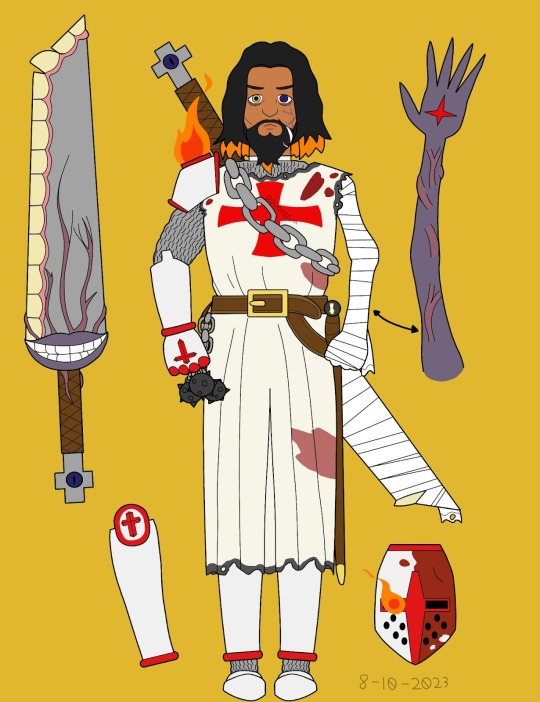


7 notes
·
View notes
Text
The special diet that kept the Knights Templar fighting fit
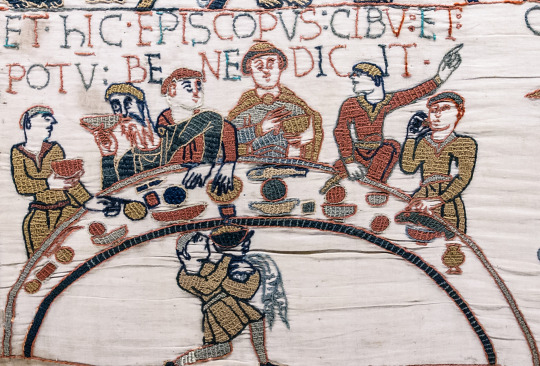
GRAYBEARDS WERE THIN ON THE ground in the 13th century. For even wealthy landholding males, average life expectancy was about 31 years, rising to 48 years for those who made it to their twenties. The Knights Templar, then, must have seemed to have some magical potion: Many members of this Catholic military order lived long past 60. And even then, they often died at the hands of their enemies, rather than from illness.
In 1314, Jacques de Molay, the order’s final Grand Master, was burned alive at the age of 70. Geoffrei de Charney, who was executed in the same year, is usually said to have been around 63. This longevity seems to have been almost commonplace. Fellow Grand Masters Thibaud Gaudin, Hugues de Payens, and Armand de Périgord, to name just a few, all lived into their sixties. For the times, this would have been positively geriatric.
“The exceptional longevity of Templar Knights was generally attributed to a special divine gift,” writes the Catholic scholar Francesco Franceschi in a journal article about their salubrious practices. But modern research suggests an alternative: The order’s compulsory dietary rules may have contributed to their long lives and good health.
Contrary to many modern portrayals, the Knights seem to have lived genuinely humble lives, in service to God. Their dietary choices and obligations reflect this. Though the order grew rich from carefully handled donations and by safeguarding traveling pilgrims’ money, the men themselves took formal vows of poverty, chastity, and obedience. They were not permitted even to speak to women. For nearly 200 years, the order thrived across Europe, peaking at around 15,000 members by the end of the 13th century. Most of all, they were expert warriors, and their ranks comprised some of the best fighters, warriors, and jousters in the world.
Early in the 12th century, the French abbot Bérnard de Clairvaux helped assemble a long and complex list of rules, which structured the knights’ lives. This rulebook became known as the Primitive Rule of the Templars, and drew from the teachings of the saints Augustine and Benedict. But many of the rules originated in the order. Though the document was completed in 1129, writes Judith Upton-Ward, the Templar Knights had already been in existence for several years, “and had built up its own traditions and customs … To a considerable extent, then, the Primitive Rule is based upon existing practices.”
The rules were many and various. The knights were to protect orphans, widows, and churches; eschew the company of “obviously excommunicated” men; and not stand up in church when praying or singing. Even sumptuary laws prioritized humbleness: Their monk’s habits were one colour alone, though on warm days between Easter and Halloween, the rules decreed, they were allowed to wear a linen shirt. (Pointed shoes were always forbidden). But the rules also extended into their dietary practices: How they ate, what they ate, and who they ate with.
Their meals do not seem to have been raucous affairs. Knights were obliged to eat together, but to do so silently. If they needed the salt, they had to ask for it to be passed “quietly and privately … with all humility and submission.” A sort of buddy system existed, partly due to a mystifying “shortage of bowls.” This may have been more a show of abstinence than anything else, like the knights’ emblem, which was of two men sharing a horse.

The knights’ diets seem to have been a balancing act between the ordinary fasting demands on monks, and the fact that these knights lived active, military lives. You couldn’t crusade, or joust, on an empty stomach. (Although the Knights Templar only jousted in combat or training—not for sport.) So three times a week, the knights were permitted to eat meat—even though it was “understood that the custom of eating flesh corrupts the body.” On Sundays, everyone ate meat, with higher-up members permitted both lunch and dinner with some kind of roast animal. Accounts from the time show that this was often beef, ham, or bacon, with salt for seasoning or to cure the meat.
It’s likely that these portions were considerable: If the knights weren’t allowed meat due to a Tuesday fast, the next day it would be available “in plenty.” One source suggests that cooks loaded enough meat onto their plates “to feed two poor men with the leftovers.”
But on Mondays, Wednesdays, and Saturdays, the knights ate more spartan, vegetable-filled meals. Although the rules describe these meals as “two or three meals of vegetables or other dishes eaten with bread,” they also often included milk, eggs, and cheese. Otherwise, they might eat potage, made with oats or pulses, gruels, or fiber-rich vegetable stews. (The wealthier brothers might mix in expensive spices, such as cumin.) In their gardens, they grew fruits and vegetables, especially Mediterranean produce such as figs, almonds, pomegranates, olives, and corn (grain).* These healthy foodstuffs likely also made their way into their meals.

All the while, brothers drank wine—but this too was restricted. Everyone had an identical ration, which was diluted, and they were advised that alcohol should “not be taken to excess, but in moderation. For Solomon said … wine corrupts the wise.” In the Holy Lands, they allegedly mixed a potent cocktail of antiseptic aloe vera, hemp, and palm wine, known as the Elixir of Jerusalem, which may have helped accelerate healing from injuries.
Franceschi describes other regulations beyond the Primitive Rules that were “specifically designed to avoid the spreading of infections.” These included mandatory handwashing before eating or praying, and exempting brothers in charge of manual tasks outdoors from food preparation or serving. Some of these innovations, picked up without any awareness of germs, may have resulted from interactions with Arab doctors, renowned during the period for their superior medical knowledge. By medieval medical standards, Templar Knights were at its apex, able to treat many illnesses and to take care of their weak.
The order was one of the richest in the world—yet these rules prevented the knights from sitting on their laurels or gorging themselves on fatty, cured meat. In fact, many of these rules resemble modern dietary advice: Lots of vegetables, meat on occasion, and wine in moderation. A meal fit not for a king on a throne, but a knight with some serious crusading to do.
Source: https://www.atlasobscura.com/articles/what-the-templar-knights-ate
4 notes
·
View notes
Text
Transcript of the first and second page:
From all that I gathered of the Grand Masters, almost all known names have an according biography. Or at least the have been mentioned by another Grand Master or other source in history. The few no one ever bothered writing down are the ones I've been asking the internet to help me out with, but, as you can see, I am nowhere closer to an answer. Someone pointed out that two of these guys' last names start with L and V, and this could be *tinfoil alarm* short or Lux Veritatis. Perhaps they were not members during the highest time of the Templars but rather the aftermath. I took a look into the history of the order to find more about the group rather than the individuals.
The name of the Knight's Templars was "poor fellow soldiers of Christ and the Temple of Solomon" which was long as heck and is not as remembered today. Their signature look instead is.- a red, thick cross with serifs on each end and quare in size. They were Christians with two main tasks set upon themselves:
to protect Christian pilgrims and European travellers on their way to the Holy Land and
to expand the Christian belief in the world.
In 1099 Christians captured Jerusalem after besieging the city and this made pilgrims travel there. Since Christians and Muslims didn't get along a lot of people got raided on their way there or even hurt or killed. To protect them was an ideal reason to make the club of the Templars.


Transcript of the third page:
In 1118 Hugues de Payens whose picture we have seen earlier created the order with eight of his relatives. In Jerusalem there was a current ruler named Baldwin II, who supported the Templars and provided a place for their headquaters. These were in the city's sacred Temple Mount, hence their short name became Templar's. The Pope was not too fond of them yet supported it somewhat in 1129, finding the idea of conquering the world in a Christian way appealing. He even granted the Templars special rights:
they didn't have to pay taxes
they were allowed to build own oratories and
they were only under the Pope's personal authority.
On the fourth page once can see the typical armor of a Templar. This white cloak had a red cross on the chest and on the back, also the shield was painted in these colors. The rest of the armor was pretty much a typical knight's armor.
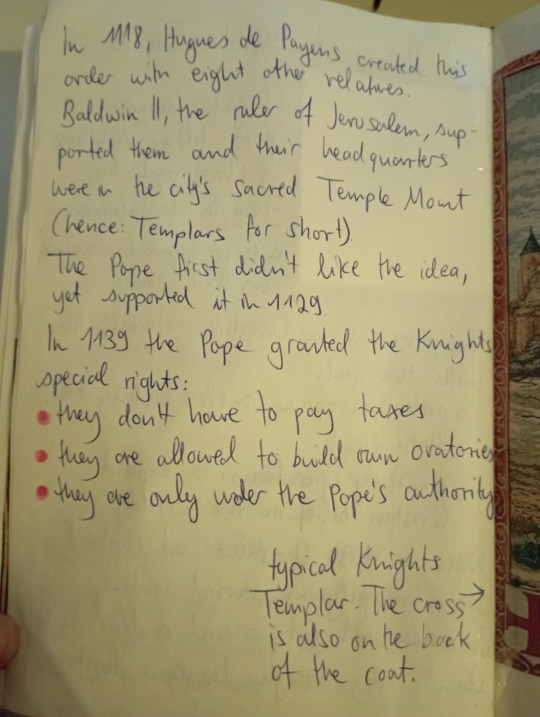

Transcript of the fifth and sixth page:
The Templars had a system almost like banks today: pilgrims could deposit any amount of money in their home cities and once reaching Jerusalem they were able to withdraw these funds- like an ATM machine. This made them also popular with regular travellers and even merchants as their wealth was secured.
As a Knight's Templar one had to follow certain rules. They were far too many and I have four pages full of them. I'll note the strangest here, you can read the others on the pictures.
there was one reason to rise earlier from the dinner table: a fire, a war cry or, strangely, nosebleeds
their clothing during times where they wouldn't go to war or outside had to be white, black or brown
not allowed were also pointy shoes (not sure if too witchy) and shoelaces (?)
they were not allowed to attack anyone despite being warrior monks unless a Christian was attacked
beards were cool when long, but long hair wasn't (too womanly)
gambling was suprisingly allowed but only with another brother with his crossbow or ten candles
Yeah don't asked me about the sense, I just distract myself from the outside world. It's good to know strange and crazy people always existed so today feels more...normal. Or at least, okay.

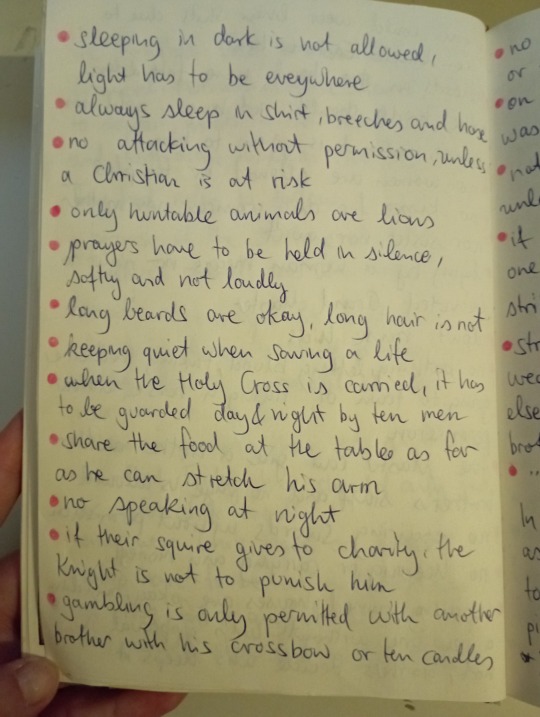
Transcript of the seventh page:
Here I have the summary on the Templars. Molay, the guy you remember, was burned with a friend on the stake and the order was dissolved in 1312. The Knight's Templars were officially gone and the Pope was anti, yet a lot of people suspected them to go underground and exist to this day. Officially, they don't, yet another group named the Freemasons revived their traditions.
Some questions arose during my research: if they really went underground, where to? Who are the Freemasons, could they be a spin-off? Or an unofficial continuation of the order?

The Freemasons were officially mentioned in 1445, that's 133 years after the Knight's Templars were wiped out. So they are not really connected or at least pretend they are not. Either way, I will look into the Freemasons now. No mention of Vasiley or Limoux. I might be even incorrect with these guys, I'm not sure. But anything is better than just listening to the radio and hearing more shops closing temporarily, more police patrolling the streets and Paris even contemplating a lockdown to protect us from the monstrum.
#tomb raider#angel of darkness#traod#classic tr#tomb raider angel of darkness#journal#aod#lara craft#tomb raider series
2 notes
·
View notes
Text
He created the latin code but rosakya wasnt satisfied with thethe theory just like she probably hates cervantes
0 notes
Text
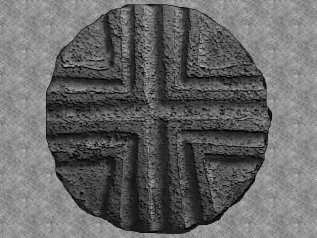
From Hugues de Payens period. Hand carved Grand Seal. Alike wax imprints were found on official documents addressed to Hugues de Payens.
0 notes
Text
A Huge Pain trying to find a history of Hugues de Payens
by
Damien F. Mackey
C12th AD or time of the Apostles?
Acts 19:1-7 describes a group of twelve disciples met by St. Paul in Corinth who had not yet evolved from John to Jesus Christ (and the Holy Spirit, the Paraclete) as had the Apostles.
Whilst there can be differing versions and variants of it, a typical account of the beginnings of the Knights Templar will go something like what we read…
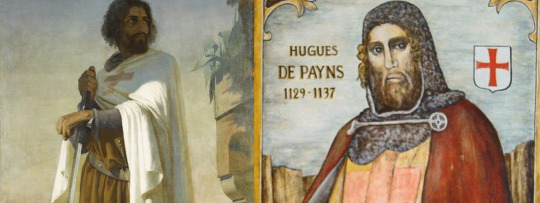
View On WordPress
0 notes
Text
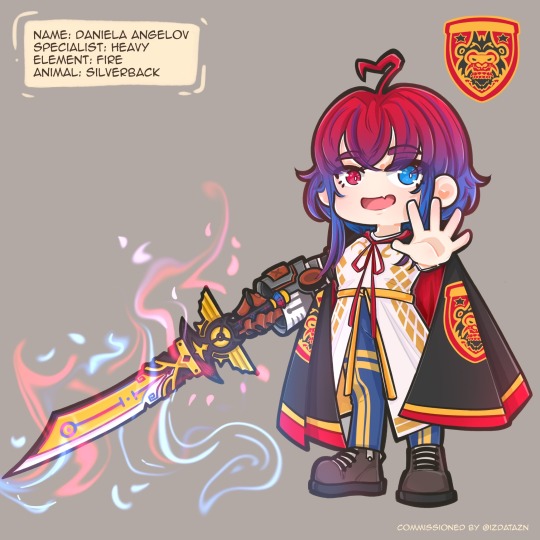
Daniela Angeloy was born in 1080 in Jerusalem, which is now modern-day Israel. She had a deep commitment to her Catholic religion during the medieval period and had a strong desire to reclaim the Holy Land from Islamic rule. Eventually, she became a member of the Knights Templar, a military order within the Catholic faith that was founded by Hugues de Payens, the Grand Master of the Knights Templar. Daniela remained dedicated to Hugues until his death. It was expected that she would succeed him as the next leader of the Grand Master position. However, she was tragically assassinated by Robert de Craon, who took Hugues' place as the Grand Master of the Knight Templar.
0 notes
Text
Misteriosul templier Hugues de Payens
”Un roman cu şi despre cavaleri, mistere şi ocultism medieval, magie şi iniţieri ezoterice. Romanul „Misteriosul templier Hugues de Payens” descrie viaţa cunoscutului cavaler Hugues de Payens, unul din fondatorii Ordinului cavalerilor templieri şi cel mai cunoscut templier. O viaţă misterioasă, plină de magie orientală şi neprevăzut, cu profunde trăiri spirituale şi vaste cunoştinţe ezoterice, cu…

View On WordPress
0 notes
Text
Entender a los templarios es entender a los normandos, y viceversa. Los templarios y los normandos estaban interconectados en sus esfuerzos, y sus caminos a menudo se entrelazaban. Dondequiera que los normandos se aventuraron, los campamentos y las actividades templarios siguieron el ejemplo.
El corazón de las operaciones templarias residía en Alta Normandía, que sirvió como el epicentro absoluto de sus actividades. Desde allí, su influencia irradió en Inglaterra, que había sido conquistada por los normandos en 1066 d.C. Los templarios establecieron campamentos en Inglaterra y el Reino de Sicilia y las regiones de Siria y Líbano, que celebraron.
Es vital enfatizar que los caballeros templarios fueron principalmente una empresa normanda. La estrecha asociación entre los templarios y los normandos no puede equivocarse. Los normandos jugaron un papel fundacional en el establecimiento y el crecimiento del orden templario, moldeando su dirección y extendiendo su alcance a través de diferentes territorios y regiones.
-- Los caballeros templarios: su presencia en Normandía y más allá
Los Caballeros Templarios, también conocidos como los Pobres Compañeros-Soldados de Cristo y el Templo de Salomón, estuvieron presentes en Normandía. Normandía, ubicada en la actual Francia, fue una de las regiones donde los templarios establecieron comanderías y poseían propiedades.
Los templarios fueron una orden militar católica fundada a principios del siglo XII. Ganaron riqueza y popularidad significativas, convirtiéndose en una de las órdenes militares más reconocidas en el cristianismo occidental. Mientras que la orden se originó en Jerusalén, ampliaron su presencia por toda Europa, estableciendo comanderías y manteniendo propiedades en varias regiones.
Normandía, el lugar de nacimiento de los normandos, que jugaron un papel destacado en la Europa medieval, acogió a comanderías templarias. Estos comanderías sirvieron como centros administrativos locales para los templarios, supervisando sus posesiones, actividades y recursos en la región. Normandía proporcionó una ubicación estratégica para que los templarios lleven a cabo sus tareas y apoyen su misión.
Los templarios no tenían su base exclusiva en Normandía. Tenían una presencia generalizada en toda Europa, con comanderías y propiedades en varios países y regiones. Normandía fue solo una de las muchas áreas donde los templarios establecieron una presencia.
Los templarios fueron iniciados por un caballero francés llamado Hugues de Payens. Aproximadamente en 1118, Hugues de Payens y ocho de sus parientes y conocidos fundaron una orden militar conocida como Compañeros Pobres Soldados de Cristo y el Templo de Salomón, que más tarde se convirtió en famosa como los Caballeros Templarios.
Los templarios se originaron en Francia y tenían fuertes lazos con el país. La sede de los templarios, a menudo conocidos como su preceptorio, se encontraba en la región de Champagne, Francia. Este lugar sirvió como centro administrativo y operativo central para la orden.
Los templarios expandieron su influencia más allá de Francia, estableciendo comanderías y propiedades en otros países y regiones de Europa y Oriente Medio. Sin embargo, la conexión francesa siguió siendo significativa, y la sede de los templarios en Champagne, Francia, jugaron un papel central en sus operaciones.
Los templarios fueron asociados con un manto blanco que les fue asignado en el Concilio de Troyes en 1129. La cruz, a menudo representada como una cruz roja, fue muy probablemente añadida a sus túnicas durante el lanzamiento de la Segunda Cruzada en 1147. Durante este evento, los templarios franceses se reunieron en su sede cerca de París, con la asistencia del Papa Eugenio III, el rey Luis VII de Francia, y otras personas destacadas
Mientras que los templarios tenían un origen francés y fuertes vínculos con el país, su influencia y actividades se extendieron más allá de Francia, abarcando otras regiones de Europa y Oriente Medio.
Fuentes:
https://www.history.com/.../middle-ages/the-knights-templar
0 notes
Link
[thien_display_title] Trendy Fashion Style Gearhomies Unisex Hawaiian Shirt Hugues de Payens Historical 3D Apparel is a hot fashion trend for sale customer. This shirt is a replica of the clothing worn by Hugues de Payens during the late medieval era. The shirt is made from 100% cotton and is available in men's and women's sizes. Gearhomies Unisex Hawaiian Shirt Hugues de Payens Historical 3D Apparel is a hot trend, new fashion product. It is perfect for sale customer who wants to look stylish and enjoy wearing tropical clothing. This shirt is made of high-quality material and it will last long. The design is exquisite and it looks very realistic. It will make you feel great wearing it and you will get a lot of compliments from your friends and family. Gearhomies Unisex Hawaiian Shirt Hugues de Payens Historical 3D Apparel is the perfect outfit for hot weather. Made from 100% cotton, this shirt is lightweight and breathable for hot days. Plus, the three-dimensional print makes it a stylish and unique piece of clothing that you'll love wearing. This Shirt Features: -Lightweight and breathable fabric -Three-dimensional print -Perfect outfit for hot weather [thien_display_title] Information: KEY FEATURES: Hawaiian shirts are great for outdoor activities like camping and beach vacations.. The lightweight fabric makes your casual wardrobe essential ideal for everyday wear. The ideal for celebrations and special occasions like: Birthdays, Housewarming gifts... PRODUCT INFORMATION: 100% woven polyester fabric, offers outstanding durability, insulation, and wrinkle resistance. Machine wash in cold with similar colors/no bleach/low iron About Shirts: Regular fit, lightweight, button-down closure all over printing shirt featuring spread collar and short sleeve. About Shorts: Flat-front casual all over printing short with side pockets, mid rise, elastic waistband. The elastic, breathable material makes it ideal for outdoor activities. PRINT: Dye-sublimation printing Care instructions: Machine wash cold, only non-chlorine bleach when needed, hang dry, cool iron on the reverse side or dry clean NOTE: - Since the size is manually measured, please allow a slight dimension difference from 1-3 cm. - Due to the different monitor and light effect, the actual colour of the item might be slightly different from the visual pictures. [thien_display_attachment_images] Our Social: Pinterest, Twitter From: Haotechcom Store
0 notes
Text
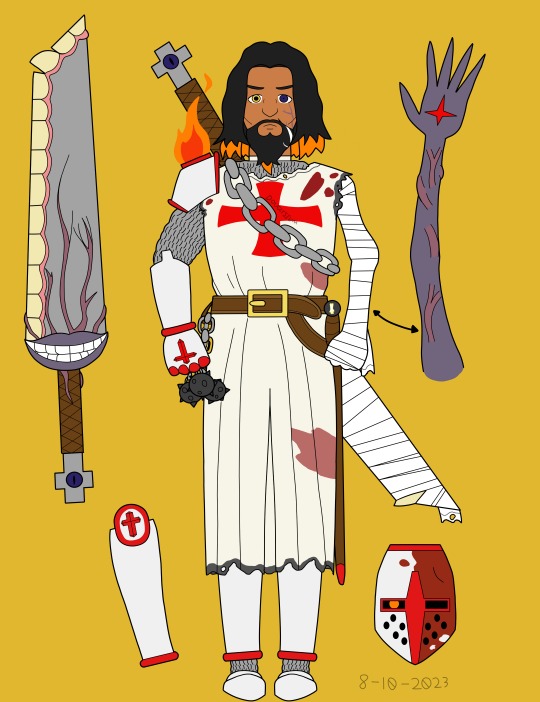
@/Omegazplayer asked me to do a fanservant design for Hugues de Payens forever ago and I decided to post the design and profile a bit early since this is taking way too long. The servant profile is finished and I only have the front profile ref done so I need to do the other refs
3 notes
·
View notes
Text
0 notes
Text
Since it's been some time I decided to get to the library and reseach a bit. Some of the Louvre staff claimed the excavation was one mystical origin; one suggested some rich Templar built his private mausoleum; most of them mentioned the possible connection the the catacombs under Paris. There is a rumor of a warrior monk spin-off called the Lux Veritatis, but virtually nothing is found in books. I think it might be something made up, or an intentionally deceitful name.
For this, I gathered some information on the Templars. If their guess is correct I have a long list of names with guys who possibly would love to remain forever known in history with a fancy tomb.
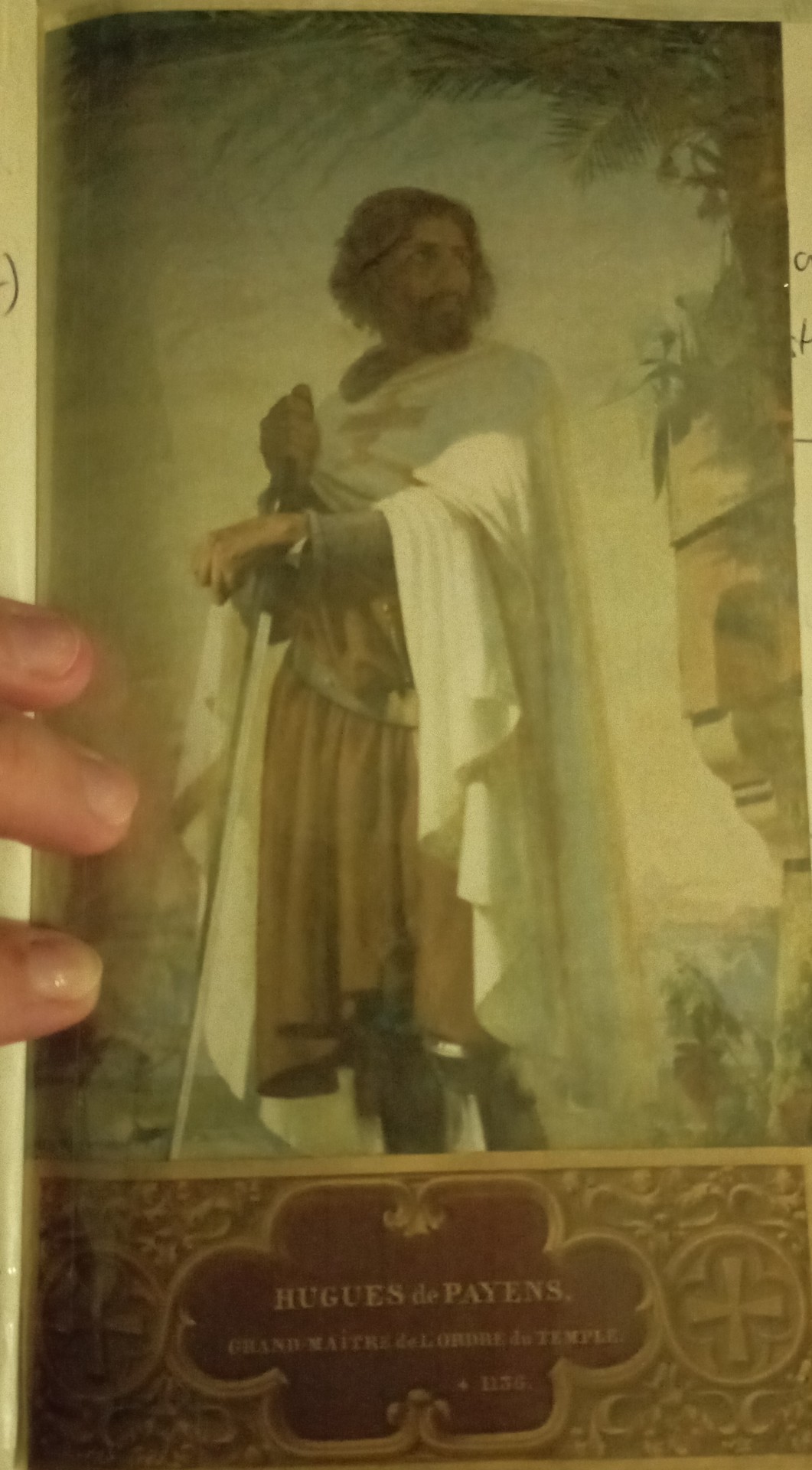
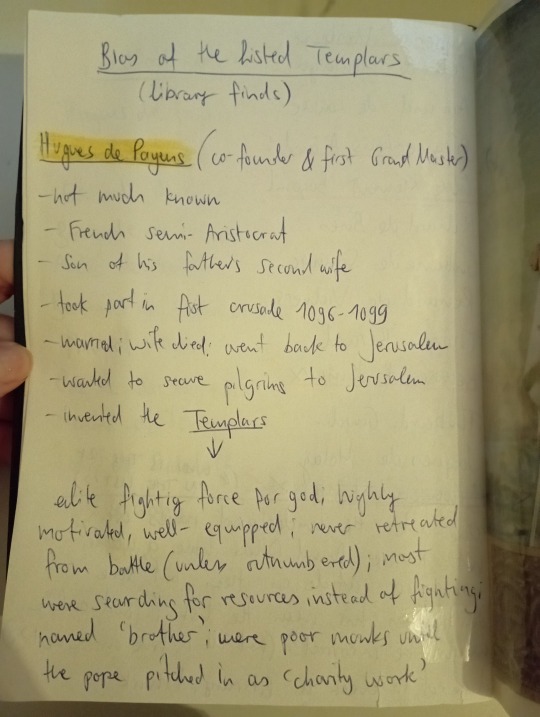
Transcript of the first page:
Hugues de Payens, co-founder of the Templars and first so called Grand Master
Not much is known about him and half the information on the Templars is bullshit anyway. He was a French (!) semi-aristocrat and wasn't even his father's first wife's child, not very Christian if you ask me. He participated in the first crusade, had a wife who died and then went back to Jerusalem where the crusades were taking place. His idea was to secure pilgrims walking from France to Israel and were attacked and ambushed sometimes and so he invented the Templars.
Templars are a club of elite Christians fighting for god, motivated by the holy bible while carrying heavy weaponry (again, very love your neighbour). They weren't rich, rejected owning a lot, embraced helping fellow Christians and mostly were just loking for ressources. Each Templar- only men were allowed- called the others "brothers". The group were not cared about by the church until the pope claimed they were doing "charity work".

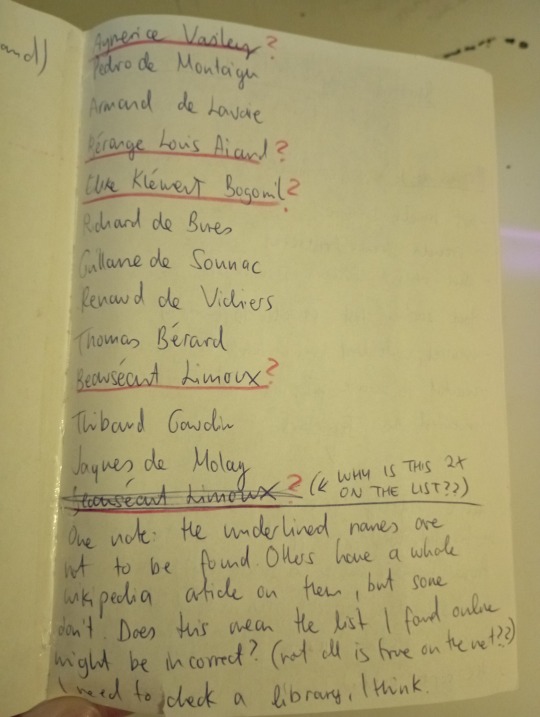
Transcript of the second and third page:
Here's a list of all the known Grand Masters within the Templars. Something I noticed is that not all names are found on the internet. I know that doesn't mean much, I have found them in books, yet I'm unable to find anything on them online. If you read this and have some clues on the following Templars:
-Genoffrei Occitan
-Aynerice Vasiley
-Bérange Louis Aicard
-Elike Klément Bogomil
-Beausécant Limoux
...please tell me. I hope I have written their names down correctly. Have you ever read of them? Do you know who they are? Any clue would be helpful.
Meanwhile I'll write down the rest of these guys and what they did during their life. Maybe one of them decided to die under the Louvre...?
#tomb raider angel of darkness#traod#classic tr#tomb raider#angel of darkness#journal#aod#lara craft#tomb raider series
1 note
·
View note